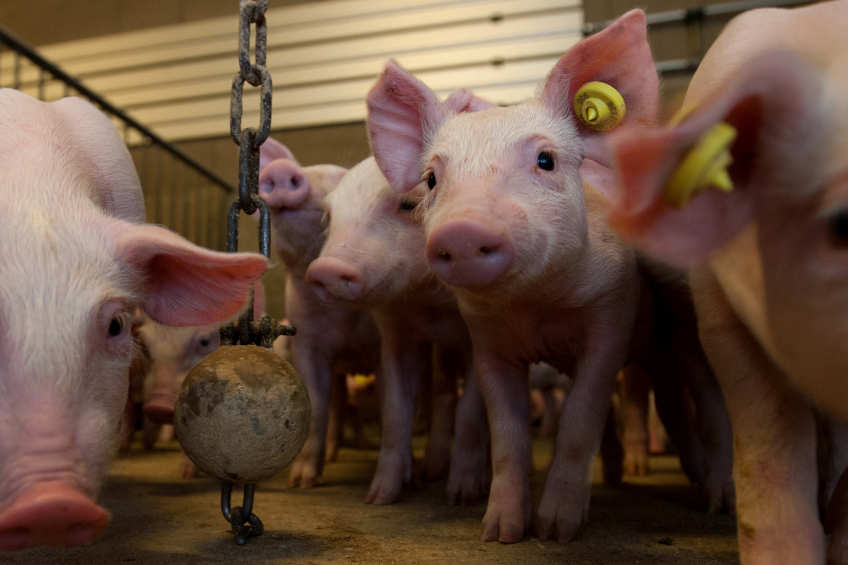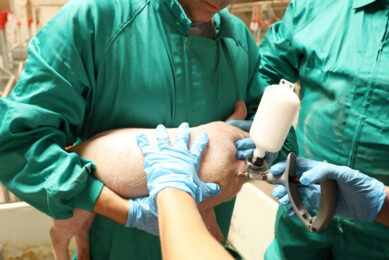Vaccination significantly reduces antibiotic use

Protection against diseases reduces the need for antimicrobials. This includes vaccinating against viral as well as bacterial diseases since it may prevent secondary bacterial infections which occur as a consequence of a weakened immune system. Vaccination provides the natural basis of a healthy pig, as the following studies have shown.
Antimicrobials are an important tool in pig disease interventions. Nevertheless increasing political pressure, retailer scrutiny and consumers expectations are forcing pig producers to reduce the usage of antimicrobials in their farms: For example, the Danish government has introduced the yellow card system, which ‘enforces legal action on pig farmers with high antimicrobial use per pig’. The Netherlands are aiming to reduce the usage of antimicrobials in livestock farming by 70% by 2015. Therefore efficient alternatives to antimicrobials routinely applied become crucial to run a successful future oriented swine business.
Vaccination stimulates the pig’s immune system
Vaccination is such an alternative. Vaccines stimulate the pig’s immune system to recognise the pathogen as foreign, destroy it, and ‘remember’ it, so that the immune system can more easily recognise and destroy any of these micro-organisms in later encounters. This leads to long-lasting protection against diseases and thereby helps to reduce the need for antimicrobials. While protection against bacterial diseases directly reduces treatments, protection against viral diseases often reduces the need for antimicrobials against secondary bacterial infections which occur as a consequence of a weakened immune system. A primed immune system improves health and provides the natural basis to achieve the biological potential of pigs. To evaluate the impact of vaccination on antimicrobial usage and pig performance 2 studies have been carried out. These studies investigate vaccination against viral (PCV2) as well as bacterial (Lawsonia intracellularis) pathogens and the results are summarised below.
Vaccination against L. intracellularis
Ileitis caused by the bacterial pathogen Lawsonia intracellularis is a widespread and economical relevant disease of pigs. Different antimicrobials can be used for the treatment of ileitis, which contributes heavily to the antibiotic consumption of weaner pigs. In contrast, vaccination against ileitis can be considered as a prophylactic tool to control clinical and subclinical ileitis. The objective of a study carried out in Denmark was to compare the use of antimicrobials against gastrointestinal diseases in weaner pigs in Lawsonia intracellularis vaccinated and non-vaccinated herds.
The analysis was based on 20 Danish pig farms:
- 10 were vaccinating against ileitis with Enterisol Ileitis (Boehringer Ingelheim) (group 1), and
- 10 were not (group 2).
Farm specific data on antimicrobial prescriptions were used to derive the average animal daily dose (ADD). The ADD describes the antimicrobial exposure independent of the choice of drug and allows a standardised comparison of different drugs used (details are available at www.danmap.org). The antimicrobial consumption for the period July to October 2011 was compared and further split up into injectable and oral administration.

Vaccinated herds needed less antimicrobials
The result of the analysis is summarised in Figure 1. Ileitis vaccinated weaner pig herds showed a significantly lower consumption than non-vaccinated herds for gastrointestinal disease related antimicrobials (-2.9 ADD, p=0.02) as well as for total antimicrobials used (-3.4 ADD, p=0.04). The ileitis vaccinated herds consumed 24% less antimicrobials, prescribed for gastrointestinal diseases and 23% less prescribed in total. The reduction of antimicrobials for ileitis did not lead to an increase of antimicrobials for other diseases. The results suggest that immunisation through vaccination represents an option for farmers to comply with antimicrobial reduction targets.
Figure 1 – 4 month average ADD/ 100 weaner pigs.

Vaccination against PCV2
Porcine circovirus type 2 (PCV2) is the main infectious agent associated with Porcine circovirus disease (PCVD), which is associated with severe economic losses in pig farms. In Europe, the America’s, and many Asian countries, vaccination against PCV2 has become standard, effectively prevented PCVD, and is greatly improving general pig health.
Study period: weaning to market
In a study, PCV2 vaccination was initiated in a high health commercial 2,800 sow 3 site pig production system in Western Canada. The performance and health of the sow herd (27.7 pigs per sow per year) was considered excellent. Piglets were vaccinated at an average of 20 days of age (weaning) with a single dose PCV2 vaccine (Ingelvac CircoFlex, Boehringer Ingelheim). Performance and financial data before and after the vaccination was chosen for a retrospective analysis. 6 production batches prior to the introduction of PCV2 vaccination and 6 production batches from after the onset of vaccination were analysed. A production batch was defined as the time period from weaning (20 days of age) through to marketing.
Financial benefits of vaccination
Improvements in a multiple of performance and financial metrics occurred within the subsequent 6 batches following the initiation of the PCV2 vaccination protocol. Total culls prior to market were reduced markedly from an average of 6.6% to 2.7% (p=0.004) following introduction of PCV2 vaccination to the system. Furthermore mortality was reduced by more than half from 5.39% to 2.05% (p=0.009). Average daily weight gain (Figure 2) was improved throughout the system overall by an average of 68 g from 845 g to 913 g (p=0.04). The reduction in mortality and attrition (increased full value markets) and advances in other performance and productivity metrics translated into system wide progress in terms of on-going improvements in herd and individual health as well as a decrease in overall medication usage which is shown in Figure 3. This declining trend in overall medication use was mirrored in feed, water, and injectable medication usage charts.
Figure 2 – Average Daily Weight Gain from wean to finish by production batch.

When evaluating performance and financial records provided by the system it became clear that the 6 production batches that received vaccination for PCV2 had a yearly return on investment (ROI) of $6.60 for each $1 invested in vaccine versus the 6 production batches that were not vaccinated for PCV2. This retrospective analysis demonstrates that the use of one dose PCV2 vaccine at the time of weaning can control PCVD, improve performance, reduce antibiotic use and improve animal welfare while generating a greater return to the producer. This example also demonstrates that PCV2 vaccination can significantly contribute to more prudent use of antimicrobials in food producing animals, which is in line with current consumer and retail demands.
Figure 3 – Overall medication costs by quarter for 6 production batches.

Conclusions from vaccination studies
The described studies show that immunisation through vaccines can significantly reduce the need for antimicrobials whilst improving the physiological and economic performance of pig production. Vaccination prevents disease, increases pig health and thereby provides the basis to realise the biological and economic potential of pigs. Therefore vaccination allows alignment among the expectations of producers, retailers and customers. Furthermore, vaccines fulfil regulatory needs.
On the one hand, vaccines have to prove their safety and efficacy in the registration process and therefore are a reliable tool to improve pig health. On the other, vaccines support farmers to comply with mandatory reduction of antimicrobials applied in certain countries.
Overall prevention of disease through vaccination addresses the environmental, social and economic requirements of modern pig farming and hence can be seen as a crucial element for a sustainable pork production.
Authors: H. Bundgaard, Porcus Pig Practice, Denmark; E. Brockhoff, Prairie Swine Health Services, Canada; and C. Misutka, Prairie Swine Health Services, Canada.











